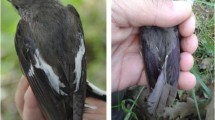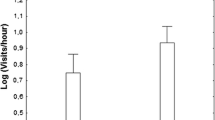Summary
This study investigated whether reduced male aid in defending offspring potentially reduces the fitness of females choosing already-mated males in the house wren (Troglodytes aedon), a small, territorial songbird. Frozen snakes were placed at 23 nests of monogamously mated males and 12 “secondary” nests of bigamously mated males. All presentations were made during incubation stages of females attending focal nests. Snakes were placed at nests of secondary females when nests of their primary counterparts contained young 5–9 days old. Males are most attentive to primary nests during this period and should therefore be relatively inattentive to secondary mates and nests. Nevertheless, an equal proportion of monogamous and bigamous males discovered snakes within 15 min, and mean time to discovery, when discovery occurred, did not differ with nest status. Monogamous and bigamous males were also equally likely to attack snakes physically once discovered. Monogamous males appeared no more likely to discover snakes than bigamous males for two main reasons. First, although monogamous males were near focal nests (i.e., < 10 m) more often than bigamous males, monogamous males tended to stay out of view of nests for long periods. In contrast, bigamous males always went immediately to focal nests upon arriving in their vicinity. Second, about one-third of monogamous males in this study spent much of their time during trials at the far edges of their territories advertising for secondary mates. Our experiment suggests that reduced male aid in defending nests against small, diurnal predators probably does not contribute to the cost of polygyny in house wrens.
Similar content being viewed by others
References
Campbell RW (1969) Notes on some foods of the wandering garter snake on Mitlenatch Island, British Columbia. Syesis 2:183–187
Carpenter CC (1951) Young goldfinches eaten by garter snake. Wilson Bull 63:117–118
Gregory PT (1978) Feeding habits and diet overlap of three species of garter snakes (Thamnophis) on Vancouver Island. Can J Zool 56:1567–1974
James DK, Petrinovich L, Patterson TL (1983) Predation of white-crowned sparrow nestlings by the western terrestrial garter snake in San Francisco, California. Copeia 1983:511–513
Johnson LS (1992) Tests of alternative hypotheses for the occurrence of territorial polygyny in birds using house wrens (Troglodytes aedon). Unpubl Ph D thesis, University of Calgary, Calgary, Alberta, Canada
Johnson LS, Kermott LH (1990a) Structure and context of female song in a north-temperate population of house wrens. J Field Ornithol 61:273–284
Johnson LS, Kermott LH (1990b) Possible causes of territory takeovers in a north-temperate population of house wrens. Auk 107:781–784
Johnson LS, Kermott LH (1991a) The functions of song in male house wrens (Troglodytes aedon). Behaviour 116:190–209
Johnson LS, Kermott LH (1991b) Effect of nest-site supplementation on polygynous behavior in the house wren (Troglodytes aedon). Condor 93:784–787
Johnson LS, Kermott LH (1993) Why is reduced male parental assistance detrimental to the reproductive success of secondary female house wrens? Anim Behav 46 (in press)
Johnson LS, Kermott LH, Lein MR (1993) The cost of polygyny in the house wren Troglodytes aedon. J Anim Ecol (in press)
Kermott LH, Johnson LS (1990) Brood adoption and apparent infanticide in a north-temperate population of house wrens. ] Wilson Bull 102:333–336
Kermott LH, Johnson LS, Merkle MS (1991) Experimental evidence for the function of mate replacement and infanticide by males in a north-temperate population of house wrens. Condor 93:630–636
Knight RL, Temple SA (1988) Nest-defense behavior in the redwinged blackbird. Condor 90:193–200
Montgomerie RD, Weatherhead PJ (1988) Risks and rewards of nest defence by parent birds. Q Rev Biol 63:167–187
Price DK (1986) Ecological, behavioral, and genetical analysis of house wren (Troglodytes aedon) mating systems. MS thesis, Illinois St Univ, Normal
Quinn MS, Holroyd GL (1992) Asynchronous polygyny in the house wren. Auk 109:192–195
Redondo T (1989) Avian nest defence: theoretical models and evidence. Behaviour 111:161–195
Searcy WA, Yasukawa K (1989) Alternative models of territorial polygyny in birds. Am Nat 134:323–343
Walkinshaw L (1943) Snakes destroying birds' eggs and young. Wilson Bull 55:56
Weatherhead PJ (1990) Nest defence as shareable paternal care in red-winged blackbirds. Anim Behav 39:1173–1178
Winkler D (1992) Causes and consequences of variation in parental defense behavior by tree swallows. Condor 94:502–520
Wittenberger JF, Tilson RL (1980) The evolution of monogamy: hypotheses and evidence. Annu Rev Ecol Syst 11:197–232
Yasukawa K, Whittenberger LK, Nielson TA (1992) Anti-predator vigilance in the red-winged blackbird, Agelaius phoeniceus: do males act as sentinels? Anim Behav 43:961–969
Author information
Authors and Affiliations
Additional information
Correspondence to: L.S. Johnson
Rights and permissions
About this article
Cite this article
Johnson, L.S., Albrecht, D.J. Does the cost of polygyny in house wrens include reduced male assistance in defending offspring?. Behav Ecol Sociobiol 33, 131–136 (1993). https://doi.org/10.1007/BF00171664
Received:
Accepted:
Issue Date:
DOI: https://doi.org/10.1007/BF00171664




